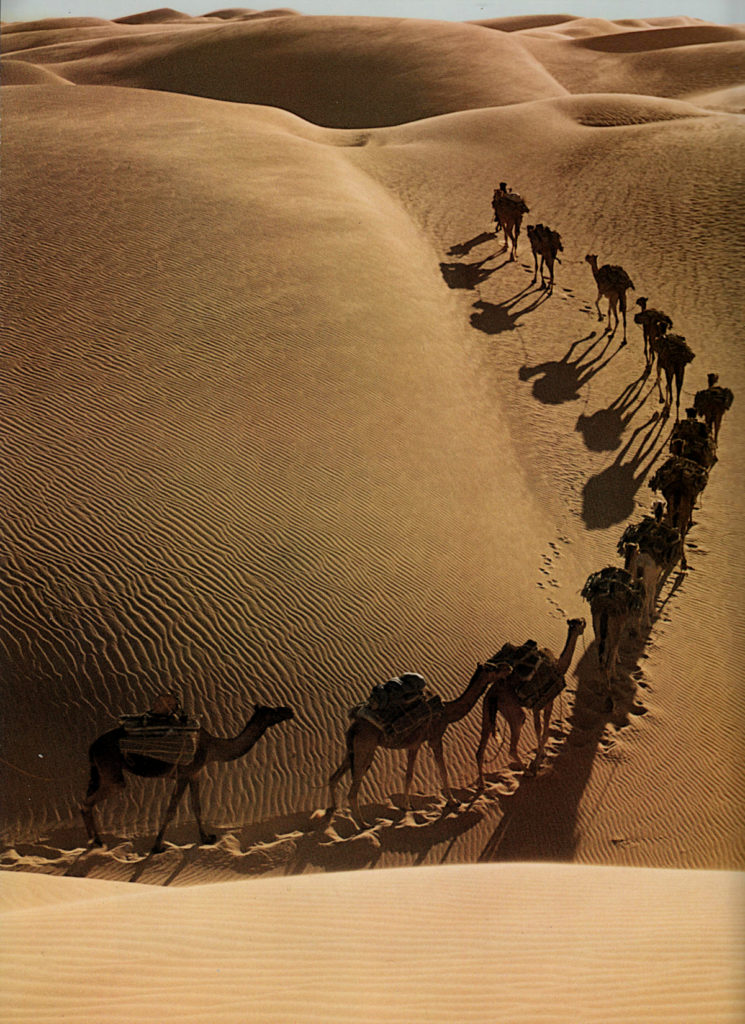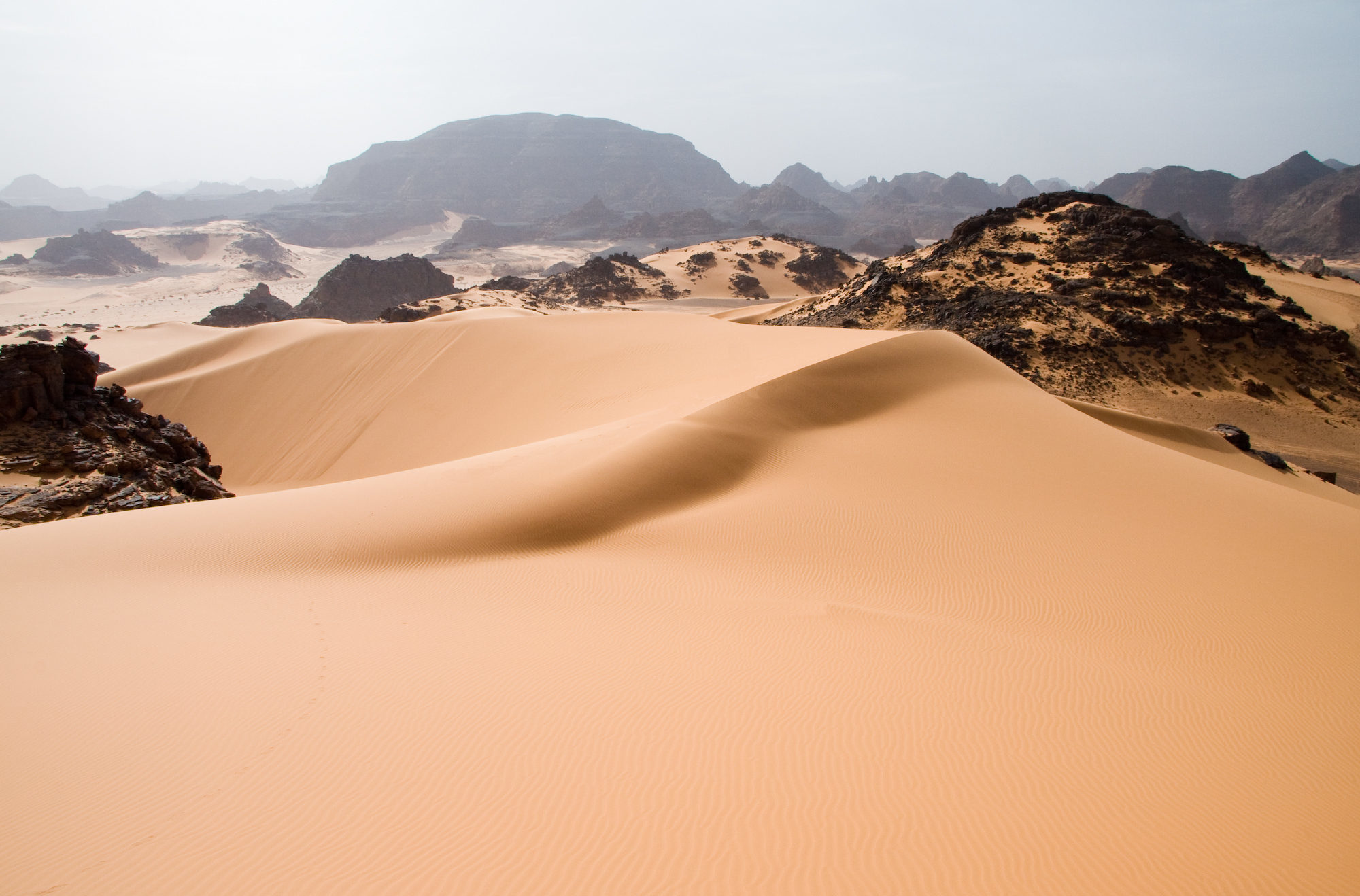
A salt caravan from the Oasis of Klima on the way…
The nomadic tribes of the Tahari desert live hard lives. There is a nearly constant hot wind that blows in the desert but it is welcomed as it makes the desert bearable. The wind is not a problem except in the spring, should it blow from the east, or in the fall, should it blow from the west. But, the nights are cool and may even be chilly. Shelter trenches may be built for protection in the desert. This is a narrow trench, four to five feet deep and eighteen inches wide. It provides shade from the sun and is much cooler as well. A trench is always dug with its long axis perpendicular to the path of the sun for maximum amount and length of shade. The sand surface can reach a temperature of 175 degrees Fahrenheit on its surface and 140 degrees in the shade. But, only a foot below the surface, the temperature can drop 50 degrees.
Sand storms in the desert seldom really bury anything. The sand is usually blasted away as soon as it is deposited in the desert. Decomposition in the desert also proceeds very slowly. Well preserved bodies have been found that were dead over a hundred years. Skeletons, unless picked by animals, are seldom found in the desert.
The conservation of water is the key to survival in the desert. One generally does not move without water on the sands during the day. One tries to move and sweat as little as possible. Their garments are loose and voluminous yet closely woven. Their outer garments are often white, a color that will reflect the sun. The looseness of the garments acts as a bellows, circulating air over damp skin, and cooling the body by evaporation. The close weave keeps moisture as much as possible within the garment, condensing it back on the skin
It rains very rarely in the Tahari. Years may pass without rain in some areas. When rain does fall, it is sometimes very fierce and can turn the terrain into a quagmire. Following the rains, great clouds of sand flies awaken and become pests. The nomads will leave water arrows, markers that indicate the direction of water holes, underground cisterns or oases. They also sometimes dig up rocks at night, clean them and leave them so dew can form on them in the morning. They will then lick the dew off in the morning. When water is in short supply, the nomads will not eat. Digestion requires a lot of water. It may take weeks to starve but only two days to die of thirst. Most of the water in the Tahari is unclear and slightly salty. The destruction of a water source is an inconceivable offense, the most heinous crime there is in the Tahari. It will unite the tribesmen and nomads against the offender.
There are several types of flora indigenous or common to the Tahari region. The flahdah is a tree with lanceolate leaves. The trunk leans like a palm tree so that it looks like a flat-topped umbrella on a crooked stick. They are not more than twenty feet high.
Kanda grows primarily in the desert regions and is a shrub that yields a toxic poison by grinding and drying its roots. The green leaves of the shrub are relatively harmless though. They can be formed into strings and chewed or sucked. But, they are addictive. The poison can be made into a paste and applied to a weapon. The softened residue of the glaze will look white on a blade. The Tor shrub has various other names, mostly translated as either “bright shrub” or “shrub of light.” It has many bright flowers, either yellow or white, and blooms in the fall. Desert veminium is a small purplish flower that may be used to make perfume. The flowers are boiled in water and the vapors are then condensed into an oil. In the Tahari, this oil may be added to water and used to wash the eating hand before and after dinner.
The nomadic tribes commonly move from one area of verr grass to another or from one water hole to another. The smaller water holes are used in the spring as they will be the first to go dry. Grass does not grow at those holes because of all the animals that graze there. They are little more than muddy ponds with a few stunted trees. These nomads trade with the oasis communities. They trade meat, hides and animal-hair cloth to the oases for Sa-Tarna grain and Bazi tea.
Sa-Tarna is the main staple of the nomads. Most people are familiar with the normal yellow Sa-Tarna grain that is the staple of much of Gor. But, there is a hybrid brownish variety that was adapted for the heat of the desert and grows in the Tahari region. Bazi tea is usually served in the Tahari in three tiny cups, carefully measured, in rapid succession. Each cup might hold two ounces. Most people in the Tahari savor strong tastes and smells, such as hot peppers. Even their children enjoy them.
Water in an oasis is at its lowest point. Residences will be built on the higher ground where nothing will grow. Land that can grow food is not wasted on housing. The oasis communities engage in much farming. They grow a multitude of products such as Sa-Tarna, beans, berries, onions, melons, turnips, carrots, radishes, larma, tospits, katch, kort, apricots, melons, suls, and pomegranates. Due to their warm climate, they generally have two growing seasons so they have little need to import food. Kaiila and verr herds are kept in the oases though they are not numerous. The nomads are the primary herders of kaiila. The nomads eat little meat. They consider their animals too precious because of their hair, milk and trade value. The nomadic raiders though eat much meat.
At a camp, nomads will settle close to a tree for shade and they will also hang their goods from the tree. At night in the camps, the kaiila, hobbled, will be put into circles of ten and fodder will be placed within each circle. Slave girls will also be hobbled. The nights are chilly so their tents will usually be situated east so the rising sun will warm them in the morning. Chronometers are rare and they use such matters as the speed of the kaiila, the circle and the stick, and the sun, to tell time.
The desert or sand kaiila is an important animal in the Tahari. It is very similar to the kaiila used by the Wagon People which is also known as the southern kaiila. Desert kaiila are almost all tawny colored though there are some black ones. They are omnivorous creatures that suckle their young. They feed more frequently than the southern kaiila. Their paws are much broader than southern kaiila and the digits are webbed with leathery fibers and heavily padded. Kailla milk is reddish and has a strong salty taste. Their hair is never sheared though it is gathered when it sheds. The most prized hair is a soft fine hair found on its belly. Zadits are small, tawny-feathered, sharp- billed birds of the Tahari. They are insectivorous, feeding on sand flies and other insects. It will often land on kaiila and eat the insects on this animal. But, they leave small wounds on the kaiila that the drovers must treat with a poultice of kaiila dung.
Their kaiila saddles are high, light saddles. Saddles are highly prized and men carry their own. They won’t allow a slave to carry their saddles. The kailla rein is a single rein, very light, plaited of various leathers. There are often ten to twelve strips in a single rein, each strip being little thicker than a stout thread. The rein is tied through a hole, drilled in the right nostril of the kaiila. It then passes under the jaw to the left. To direct the animal to the left, you draw the rein left. To direct to the right, draw the rein right with pressure on the left cheek. To stop the beast, you draw back on the rein. To start or speed up the animal, kick it in the flanks or use a kaiila quirt. Caravan kailla have many bells on them to keep the animals together. They are easier to find at night and in limited visibility such as in sand storms. But, kaiila of raiders are never belled.
